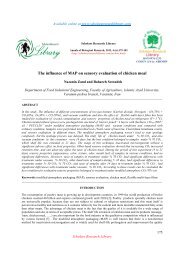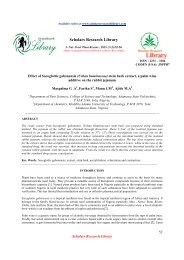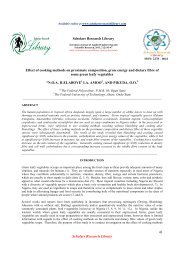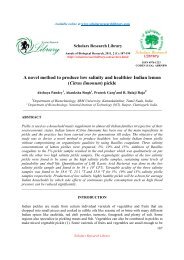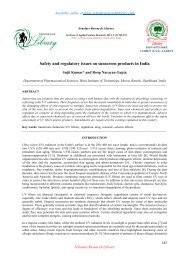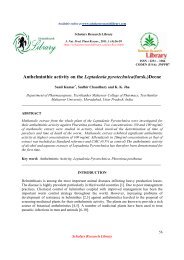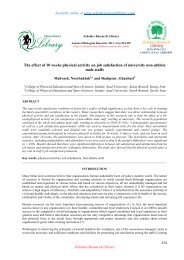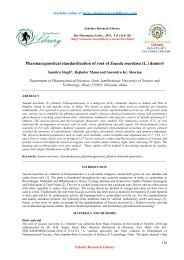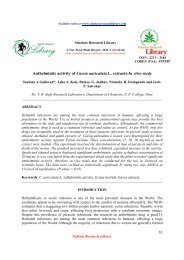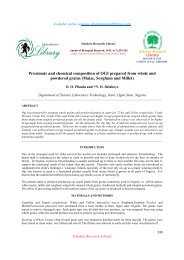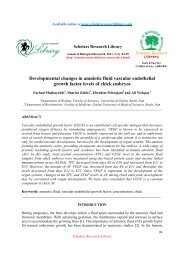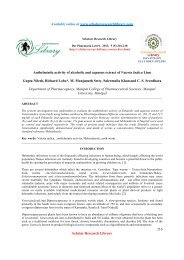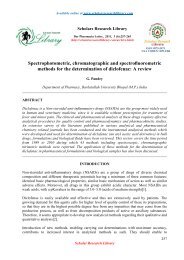Phytochemical analysis, in-vitro screening for antimicrobial and ...
Phytochemical analysis, in-vitro screening for antimicrobial and ...
Phytochemical analysis, in-vitro screening for antimicrobial and ...
You also want an ePaper? Increase the reach of your titles
YUMPU automatically turns print PDFs into web optimized ePapers that Google loves.
G. V. Pavan Kumar et al Der Pharmacia Lettre, 2013, 5 (1):168-176<br />
_____________________________________________________________________________<br />
concentration of 50 mg/ml, <strong>in</strong> shorter time. Possible mechanism <strong>for</strong> anthelm<strong>in</strong>tic effect of seed extract of plants are<br />
due to presence of secondary metabolites that they can b<strong>in</strong>d to free prote<strong>in</strong>s <strong>in</strong> the gastro<strong>in</strong>test<strong>in</strong>al tract of host<br />
animal or glycoprote<strong>in</strong> on the cuticle of the parasite <strong>and</strong> may cause death. In addition, Tann<strong>in</strong>s or their metabolites<br />
have a direct effect on the viability of the pre- parasitic stages of helm<strong>in</strong>thes <strong>and</strong> other phytochemicals may be<br />
responsible <strong>for</strong> an anthelm<strong>in</strong>tic effect <strong>in</strong>clude essential oils, flavonoids <strong>and</strong> terpenoids .This speculation is supported<br />
by the vary<strong>in</strong>g rates of effectiveness of medic<strong>in</strong>al plants. The above results show that the activity of hydroalcohol<br />
extracts shows significant antibacterial <strong>and</strong> antifungal activities. This study also shows the presence of different<br />
phytochemicals with biological activity that can be of valuable therapeutic <strong>in</strong>dex. The result of phytochemicals <strong>in</strong><br />
the present <strong>in</strong>vestigation showed that the plant conta<strong>in</strong>s more or less same components like triterpenoids, steroids,<br />
glycosides, anthraqu<strong>in</strong>one, flavonoids, prote<strong>in</strong>s, <strong>and</strong> am<strong>in</strong>o acids. Results show that plant rich <strong>in</strong> tann<strong>in</strong> <strong>and</strong> phenolic<br />
compounds have been shown to posses <strong>antimicrobial</strong> activities aga<strong>in</strong>st a number of microorganisms.<br />
CONCLUSION<br />
In the current <strong>in</strong>vestigation, the hydroalcohol extract <strong>in</strong> the ratio of 30:70 has been selected after study of such a<br />
selected plant with water extracts <strong>and</strong> methanol extracts, hydroalcohol extract gave higher yield of chemical<br />
constituents expected <strong>for</strong> this research work. The orig<strong>in</strong>ality of this work is that good results have been found with<br />
hydroalcohol ratio, <strong>and</strong> it will be helpful to carry out other data with MIC <strong>and</strong> other <strong>for</strong>mulation study, because <strong>in</strong><br />
comparison of methanol or water extracts, hydroalcohol is more suitable <strong>for</strong> cl<strong>in</strong>ical study. The hydroalcoholic<br />
extracts of four plant seeds were found to be active on most of the cl<strong>in</strong>ically isolated microorganism <strong>and</strong> fungi, as<br />
compared with st<strong>and</strong>ard drugs. The present study justified the claimed uses of seeds <strong>in</strong> the traditional system of<br />
medic<strong>in</strong>e to treat various <strong>in</strong>fectious disease caused by the microbes. However, further studies are needed to better<br />
evaluate the potential effectiveness of the crude extracts as the <strong>antimicrobial</strong> agents. The present results will <strong>for</strong>m<br />
the basis <strong>for</strong> selection of plant species <strong>for</strong> further <strong>in</strong>vestigation <strong>in</strong> the potential discovery of new natural bioactive<br />
compounds.<br />
Biological parameter can be concluded that the plants Cori<strong>and</strong>rum sativum,Cassia occidentalis,Carica<br />
papaya,Momordica foetida has significant anthelm<strong>in</strong>tic activity. Further studies us<strong>in</strong>g <strong>in</strong>vivo model are required to<br />
f<strong>in</strong>d out <strong>and</strong> to establish effectiveness <strong>and</strong> pharmacological rationale <strong>for</strong> the use of seeds as anthelm<strong>in</strong>tic drug. In the<br />
light of above mentioned pharmacological effects, it may be concluded that comb<strong>in</strong>ed Hydroalcoholic extract has<br />
the maximum anthelm<strong>in</strong>tic activity.<br />
Acknowledgement<br />
We are grateful to our chairman Dr.Mannava Radha Krishna murthy ,H<strong>in</strong>du college of pharmacy Guntur ,A.P, India<br />
<strong>for</strong> provid<strong>in</strong>g Lab facilities <strong>for</strong> this research work.<br />
REFERENCES<br />
[1] Ajaiyeoba EO, Onocha PA, Olarenwaju OT. Pharm Biol 2001; 39:217- 220.<br />
[2] Al-Said, M.S., Al-Khamis, K.I., Islam, M.W., Parmar, N.S.,Tariq, M., Ageel, A.M., 1987. Journal of<br />
Ethnopharmacology 21, 165–173.<br />
[3] Kudav NA, Kulkarni AB. Ind. J .Chem 1974;12:1042–4.<br />
[4] G<strong>in</strong>de BS, Hosangadi BD, Kudav NA, Nyak KV, Kulkarni AB. I. Chem. Soc. 1970:1285–9.<br />
[5] Aruoma, O.I., Colognato, R., Fontana, I., Gartlon, J., Migliore, L., Koike, K., Coecke, S., Lamy, E., Mersch-<br />
Sundermann, V., Laurenza, I., Benzi, L., Yosh<strong>in</strong>o, F., Kobayashi, K., Lee, M.C., 2006. Biofactors 26 (2), 147–159.<br />
[6] Hakizamungu, E., Van Puyvelde, L., Wery, M., 1992. Journal of Ethnopharmacology 36, 143–146.<br />
[7] Raman, A., Lau, C., 1996. Phytomedic<strong>in</strong>e 2, 349–362.<br />
[8] Husa<strong>in</strong>, J., Tickle, I.J., Wood, S.P., 1994. FEBS Letters 342, 154–158.<br />
[9] Putnam, C.D., Ta<strong>in</strong>er, J.A., 2000. Natural <strong>and</strong> Structural Biology 7, 17–18.<br />
[10] Miura, S., Funatsu, G., 1995. Bioscience Biotechnology <strong>and</strong> Biochemistry 59, 469–473.<br />
[11] Kh<strong>and</strong>elwal KR. 2nd ed. Pune: Nirali Prakashan; 2009. Practical Pharmacognosy; pp. 149-156.<br />
[12] Kokate CK. Delhi: New Gyan Offset Pr<strong>in</strong>ters; 2000. Practical Pharmacognosy; pp. 107– 109.<br />
[13] Kumar A, Ilavarasan R, Jayach<strong>and</strong>ran, Decaraman M, Arav<strong>in</strong>dhan P. Pak J Nutr. 2009;8:83–85.<br />
[14] Harborne JB. Chapman <strong>and</strong> Hall. Newyork: 1973. <strong>Phytochemical</strong> methods: A guide to modern techniques of<br />
plant <strong>analysis</strong>; pp. 279–19.<br />
[15] Maidment C, Dyson A, Haysom I. Nutr.Food Sci 2006; 36 (4): 225 - 230.<br />
Scholar Research Library<br />
175



